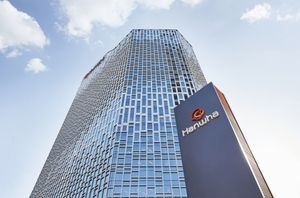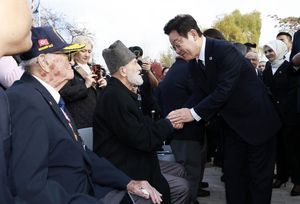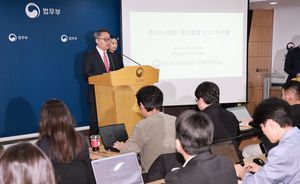 My family spent the long Chuseok holiday in Yeosu. The southeastern coastal city is not new to me. I remember the city decked out and festive while it hosted the International Expo in 2012. But after that visit, I had little reason to go back. Then, just a couple of years ago, I rediscovered Yeosu during an impulse trip to a newly opened hotel on the beach. And ever since, the city has become my favorite place to visit in Korea — to drink in the energy of the spectacular jade-colored ocean that flows ever so calmly. And it has become a passion of mine to sing its praises, to declare it the ultimate hidden gem of Korea’s southern coast.
My family spent the long Chuseok holiday in Yeosu. The southeastern coastal city is not new to me. I remember the city decked out and festive while it hosted the International Expo in 2012. But after that visit, I had little reason to go back. Then, just a couple of years ago, I rediscovered Yeosu during an impulse trip to a newly opened hotel on the beach. And ever since, the city has become my favorite place to visit in Korea — to drink in the energy of the spectacular jade-colored ocean that flows ever so calmly. And it has become a passion of mine to sing its praises, to declare it the ultimate hidden gem of Korea’s southern coast.
First off, the city has a song, “Yeosu Ocean at Night.” Not of the bubbly K-pop variety, but a hugely popular melodic ballad that aptly reflects its true allure. Korea’s largest port city, Busan, may have the soulful “Return to the Port of Busan” sung by the legendary crooner Cho Young-pil. But “Yeosu Ocean at Night” is a slow, quiet but definitely addictive tune, courtesy of the band Busker, Busker. In fact, the number of visitors to Yeosu is said to have doubled the year after this song was released in 2012.
The song is pretty much a repetition of the title and the main refrain, “Yeosu Ocean at Night.” Repeat it a dozen or so times to the moody, catchy tune, and you’ve got it. But this chorus is actually what Yeosu is all about. The beauty and silence of the calm ocean, especially at night, belies its strength and power.
The calmness of Yeosu’s ocean mainly comes from its geographical characteristics. It is enclosed by a myriad of islands — about 365 of them, in fact. The islands, acting as natural barriers, break up waves and strong currents. That is why almost every part of the coastline offers spectacular views of silhouettes of different islands. Of course, the most famous one is Odongdo, known for its natural beauty, especially its camellia, which blossom bright in the winter months. But there are also many that were given names by locals for their shapes — one for how it invokes images of a dragon’s head, a cow’s head, (many heads rising out of the water!) and even one for its similarity to the head and shell of a turtle.
Perhaps that was why one of Korea’s most famous naval inventions, the turtle ship, or geobukseon, was born here. In 1591, Adm. Yi Sun-sin was appointed commander of the Jeolla Naval Base, which was located in Yeosu, and set out to prepare his troops for the invasion of Japanese naval forces, which he is said to have had the foresight to anticipate.
He trained his sailors to move swiftly and with expert precision through the narrow straits and shallow bays of Yeosu. And he designed and built the world’s first ironclad warship, shaped like a turtle, covering the deck with metal spikes to prevent enemy boarding and armed it with cannons that could fire in all directions. The preparations paid off as Yi, outnumbered in men and ships, proved successful in major naval battles during the the Japanese invasion of Korea from 1592 to 1598.
But the city and its surrounding waters also carry the wounds of deep tragedies. In 1948, thousands of civilians were killed in the process of suppressing a military rebellion. A memorial to those caught in the crossfire of ideological warfare also stands solemn and silent in Yeosu.
Yeosu, like many Korean cities, embodies the spirit of a country that survives and thrives. A country that fought off massive and constant foreign invasions, using every resource at its disposal. A country that endured unimaginable heartbreak due to the clash of ideologies, but also — instead of sweeping the painful memories under the rug — a country that tries to reconcile the tragedies, painful as that might be.
I feel this as I gaze at the Yeosu horizon. It is the power of a quiet ocean, its hidden depth, its harnessed power. Especially if you are used to the hustle and bustle of a metropolis like Seoul, or even Busan, you may think Yeosu is not very Korean, in its pace, its demeanor. But I dare say it is more Korean than you might imagine. It carries an emotional resonance for many Koreans — how beneath the quiet lights and waves of the Yeosu night ocean lies a sea that rages and thunders. At least, it resonates with me.
* The most convenient way to get to Yeosu from Seoul is to take the KTX from Seoul to YeosuExpo. It takes about 3 hours. More details about travel paths and what to eat in the culinary wonderland of Yeosu can be found in the VisitKorea website.
Sohn Jie-ae
Sohn Jie-ae, former CNN correspondent for Seoul and former CEO of Arirang TV and Radio, is an invited professor at the Graduate School of International Studies of Ewha Womans University. The views expressed here are the writer’s own. — Ed.
- Why veteran pansori singer Lee Ja-ram takes on one-woman battle in ‘Prima Facie’
- Father and son asylum-seekers live in airport holding room for 4 months
- HD Hyundai to showcase next-gen shipbuilding tech at APEC summit
- Free performances across Gyeongju celebrate vibrant Korean traditions ahead of APEC
- Blackpink’s Jisoo scores 1st solo entry on Billboard’s Hot 100









Most Commented